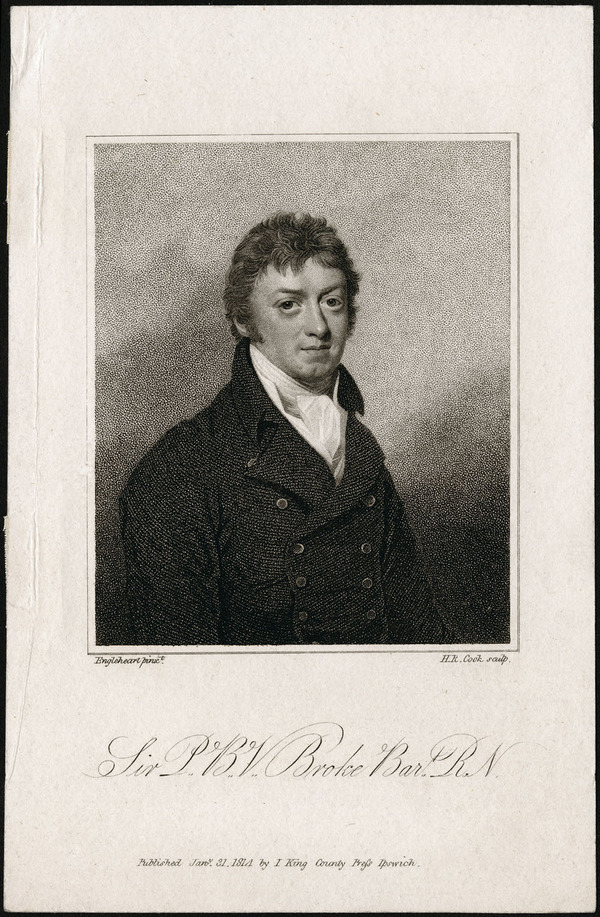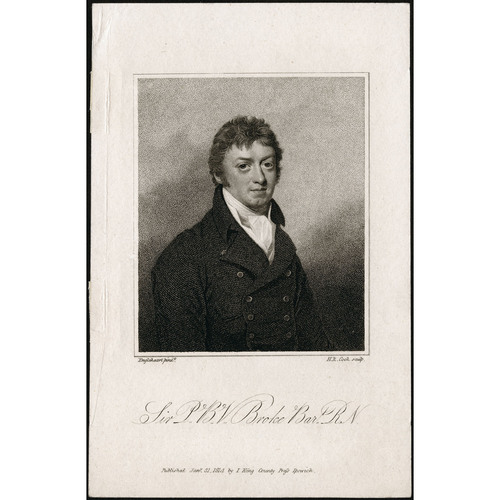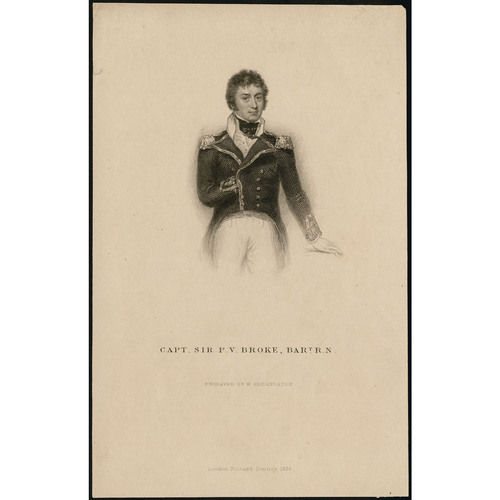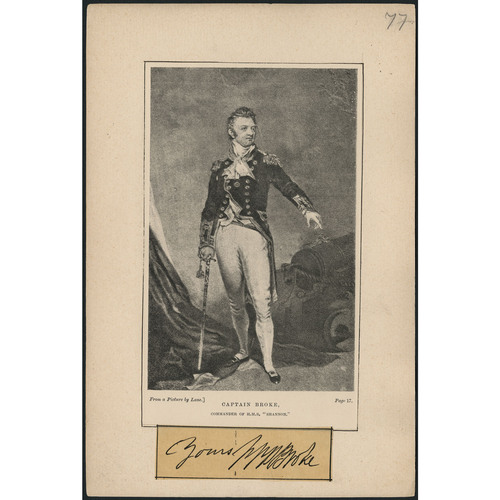As part of the funding agreement between the Dictionary of Canadian Biography and the Canadian Museum of History, we invite readers to take part in a short survey.
BROKE, Sir PHILIP BOWES VERE, naval officer; b. 9 Sept. 1776 in Broke Hall, Nacton, England, eldest son of Philip Bowes Broke and Elizabeth Beaumont; m. 25 Nov. 1802 Sarah Louisa Middleton, and they had 11 children; d. 2 Jan. 1841 in London.
Philip Bowes Vere Broke entered the Royal Naval Academy at Portsmouth in 1788 and four years later joined the Bulldog as a midshipman. A lieutenant from 1797, he was present at the battle of Cape St Vincent that year, and saw further service off Ireland and in the North Sea. On 14 Feb. 1801 he was promoted captain, and on 31 Aug. 1806 took command of the frigate Shannon. Broke was ordered to Halifax in August 1811 to join the squadron under Vice-Admiral Herbert Sawyer, and arrived there on 24 September. For the next 18 months he cruised in the western Atlantic to intercept French warships and, from mid 1812, American shipping, returning to Halifax from time to time. After assuming command of the Shannon, Broke had devoted his energies to raising the ship’s standard of gunnery, and a well thought-out program of training was followed with great care. These exertions were to produce one of the most efficient fighting ships in the Royal Navy at a time when naval gunnery was often poor.
On 21 March 1813 Broke sailed in company with the frigate Tenedos to keep watch on Boston Harbor, where several of the powerful American super-frigates had gathered. By late May, having detached the Tenedos, Broke was running short of fresh water, but he was anxious to engage one of the much-vaunted enemy vessels before returning to Halifax. On the morning of 1 June he closed the land and saw the frigate Chesapeake apparently ready for sea. He sent a written challenge to Captain James Lawrence, but before it could be delivered the American ship got under way and came up on the Shannon’s starboard quarter. At 5:50 p.m. the Shannon opened fire. The effect of her broadside was catastrophic for the Chesapeake. The men at her wheel were killed and sheets and brails shot away, so that she lost way and collided with the Shannon. The British vessel then raked her opponent, causing havoc among the enemy gun crews. Broke had the two ships lashed together and, seeing the Americans leaving their guns, led away the main deck boarders. After a brief, desperate resistance, during which Broke was badly wounded by a blow on the head from the butt of a musket, the Chesapeake surrendered, her captain mortally wounded and nearly one-half of her crew casualties. Eleven minutes had elapsed since the first shot. Although the American vessel was larger and carried a heavier armament, her crew had had little time to work together, and the victory was the result of Broke’s leadership and excellent training. Halifax hailed the appearance of the Shannon and her prize with jubilation. It is said that the clergy and choir of St Paul’s Church ran down George Street in their cassocks and surplices to see the ships.
Broke recovered sufficiently from his wound to be able to resume command of the Shannon when she sailed for England in October 1813. His victory had provided a badly needed tonic to a British public depressed by earlier American naval successes, and he was showered with honours, being made a baronet on 25 Sept. 1813 and a kcb on 3 Jan. 1815. He was also awarded the small naval gold medal given to post-captains who had distinguished themselves in action. However, much troubled by his wound, he never served at sea again, and spent most of the rest of his life at Broke Hall. There he took a keen interest in the community and was kept busy with correspondence on naval matters, chiefly gunnery. He was promoted rear-admiral of the red on 22 July 1830. In 1840 he became concerned about his health and decided to undergo an operation in London to repair the damage from his wound. He could not stand the strain and died on 2 Jan. 1841, being buried in St Martin’s Church in Nacton seven days later.
Admiral Sir P. V. B. Broke, bart., K.C.B., &c.: a memoir, comp. J. G. Brighton (London, 1866). DNB. H. F. Pullen, The “Shannon” and the “Chesapeake” (Toronto and Montreal, 1970).
Cite This Article
H. F. Pullen, “BROKE, Sir PHILIP BOWES VERE,” in Dictionary of Canadian Biography, vol. 7, University of Toronto/Université Laval, 2003–, accessed April 1, 2025, https://www.biographi.ca/en/bio/broke_philip_bowes_vere_7E.html.
The citation above shows the format for footnotes and endnotes according to the Chicago manual of style (16th edition). Information to be used in other citation formats:
| Permalink: | https://www.biographi.ca/en/bio/broke_philip_bowes_vere_7E.html |
| Author of Article: | H. F. Pullen |
| Title of Article: | BROKE, Sir PHILIP BOWES VERE |
| Publication Name: | Dictionary of Canadian Biography, vol. 7 |
| Publisher: | University of Toronto/Université Laval |
| Year of revision: | 1988 |
| Access Date: | April 1, 2025 |






